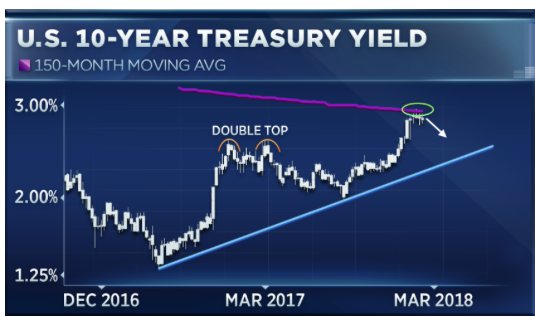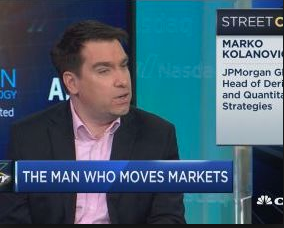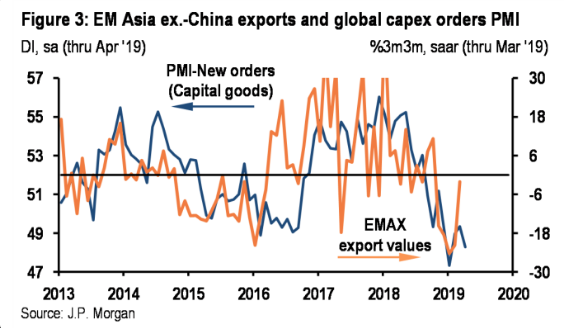After some rather innocuous economic data yesterday, equities finished the day rather uneven yesterday and across the major averages with the Dow Jones Industrial average the only index finishing higher. Today’s economic data will be highlighted through consumer sentiment and housing starts. The data comes as bond yields are seemingly peaking… for the moment? Bond yields reached a year-to-date peak of 2.94% on Feb. 21, 2018. The 10-year yield has not reached above 3% since 2014. Paul Ciana, global chief FICC technical strategist at Bank of America, told CNBC’s “Futures Now” that he has a few reasons as to why now may be a time to be countertrend, bullish bonds.

“The candle pattern structure on the 10-year in recent weeks also indicates that yields have entered overbought territory and are “at risk for rolling over to the downside. The RSI of the weekly 10-year yields chart is hovering at about 74, which means yield is overbought or the bond market is oversold to a rather stretched position and could correct. The yield on the 10-year Treasury has held around four-year highs since hitting those levels in February. The “sell yield, buy bond signal” is at its peak this year. The MACD indicator on our daily chart has already crossed lower. It’s pointing to lower yields and has plenty more room to trend lower before it truly crosses that zero line.”
The S&P 500 will try to end a 4-day losing streak today with a good deal of political angst still weighing on equities. Going into the Friday trading day, the Dow was looking at a weekly loss of 1.8 percent. The S&P was looking at a 1.4% drop and the Nasdaq 1% for the week. And this after all 3 major averages gained 1% or better last week. Moreover, Friday is also quadruple-witching day, which is defined by the simultaneous expiration of stock-index futures, stock-index options, single-stock futures and stock options. This could result in higher trading volumes and volatility.
Traders may not be all-too excitable to end the trading week ahead of next week’s more critical FOMC rate hike decision. According to the CME’s FedWatch Tool. Investors are giving it a 91.6% chance that the Fed will indeed raise rates at next week’s meeting. What may be more important than the rate hike is Fed Chair Jerome Powell’s press conference to follow the rate hike. His verbiage and depiction of the economy and inflation may provide a clearer picture and direction for equities post the press conference. Mark your calendar for next Wednesday traders!
Wal-Mart is in the final stage of negotiations to become the largest shareholder in Flipkart, India’s biggest online retail company. The U.S. retail giant plans to buy about a third of Flipkart Online Services Pvt, in part by purchasing stakes from Tiger Global Management and SoftBank Group Corporation. To begin with Wal-Mart could buy about 20-26% stake and increase its shareholding to 51% going forward.
“For Walmart, Flipkart’s acquisition is the last opportunity to counter Amazon,” said an analyst who tracks the sector. For Flipkart, this round of fresh capital comes soon after it racked up a record $4 billion in funding in 2017. Besides US retail giant Amazon, Flipkart is also competing with Chinese e-commerce major Alibaba-backed Paytm Mall.
Wal-Mart is looking to add some 1.3bn Indian customers while Flipkart is looking to fend off Amazon, which Jeff Bezos has vowed not to lose in the same way it has lost its fight for the Chinese marketplace. Bezos has pledged some $5.5bn to build out the Amazon business in India.
The news regarding Wal-Mart and Indian e-commerce player Flipkart comes on the heels of yet another brick and mortar bankruptcy/liquidation in the U.S. market. Toys R Us is officially liquidating all of its stores and will cease operations. Target, Wal-Mart and Amazon have been eating Toys R Us’ lunch for over a decade now and aim to capture the largest market share left in the wake of the retailers vacancy.
“Greg Melich of MoffettNathanson estimated in January that Toys “R” Us has 18% of the $26 billion U.S. toy market. That works out to about $4.7 billion. Morningstar’s Hottovy expects Amazon could rake in some $2 billion to $3 billion extra in sales this year out of that. He expects the rest to go to Walmart, Target, dollar stores and to direct sales from toy manufacturers.”
The issues that plagued Toys R Us are/were no different than the issues that plagued The Sports Authority, Circuit City and more recently, HHgregg. Category killers prove to be anything but… over time. Best Buy went through many struggles post the financial crisis that found the company forced to restructure and curtail its number of stores as well as international reach. Additionally, the company recently announced the closing of all its mobile store units that only launched a few years ago. While shares of BBY express strength in corporate profits presently, the company may simply be benefitting from the broader brick and mortar consolidation and low comps from previous years. I’d keep this retailer on my short, watch list over the next 12 months for signs of peaking and as its peers push further into the consumer electronics space with lower prices. At the end of the day, Best Buy lacks pricing power for consumer gadgets.
In other retail news, J.C. Penney is adding employees. The retailer announced it would add 400 employees in a variety of customer service roles. The jobs will include a mix of full-time and part-time positions centered on furniture and major appliances customer care.
“The hiring move aligns with one of the company’s key strategies for 2018 — emphasizing its furniture and appliances offerings and boosting that market share, according to its fourth-quarter earnings release. The company also stressed it would enhance its omni-channel approach. Last quarter’s earnings exceeded expectations, with comparable sales up 2.6 percent and outstanding debt reduced by more than $600 million, according to the earnings release.”
After largely accepting the “darling of Wall Street” crown during the November 2017- January 2018 period, retail names have come under great pressure, except of course Amazon. While many bulls chanted that “brick and mortar isn’t dead”, that may be very well true, but an incomplete statement at best. Brick and mortar retailers are still behind the 8-ball and fighting an uphill battle against a trend that is not likely to cease with regards to online consumption. Even more importantly is that in order to fight the online trend, the traditional brick and mortar retailers have to participate in that arena, with lesser profit margins and little to no pricing power. Certain retailers will perform better than others and, yes, long-term it will prove a zero sum game as consumer demographics and consumption habits force outcomes.
Tags: AMZN JCP SPY DJIA IWM QQQ TGT WMT










